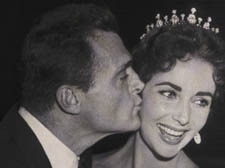
Above: Mike Todd and Elizabeth Taylor
|
Sixty years of Cannes capers
As Cannes Film Festival enters its 60th year, the glamorous and sometimes scandalous history of the movie industry’s premier event is laid bare. Review by William Hall
Cannes: Inside the World’s Premier Film Festival, Kieron Corless and Chris Darke.
Faber £14.99p. order this book
ONCE described as a cross between a trade fair and a three-ring circus, the Cannes Film Festival celebrated its incredible 60th birthday when the curtain went up last night (Wednesday).
Why incredible? Because, as this new book by show-biz journalists Kieron Corless and Chris Darke recalls, it almost failed to take off after a chaotic first year and was cancelled in both 1948 and 1950 due to lack of funds.
Since then this cumbersome vessel, frequently holed below the waterline by infighting and scandal, has sailed a stormy voyage across the cinematic seas. But somehow each year it survives to hog the headlines of the world’s ravenous media yet again.
The book is more heavy of purpose than light of heart, meticulously researched and aimed at serious students of cinema rather than a holiday beach read.
Fair enough – except that time after time I kept thinking: C’mon, fellers, lighten up. This is Cannes! Sample: “The festival’s capacity to reinvent itself through the vicissitudes of its history is exemplary…” Yes indeed it is, but let’s have some fun around here too.
Have you forgotten what Cannes is all about for the gawping stargazers along the famous Croisette, and for millions reading about it vicariously across the globe: sun, sand, sea, starlets – and sex?
The first festival was actually held in September 1946, with the local casino hastily converted into an 850-seat cinema and 52 features screened.
With 21 nations taking part that year, the place was soon bulging at the seams – particularly as the general public were invited, too.
Later, the writers report, officials complained of “ill-mannered and undisciplined locals who refused to refrain from smoking during screenings, and grabbed the best seats, often smuggling three or four people in on a single invitation”.
They were still doing it when I was there for 18 years running in the 1970s and 1980s
The book is predictably full of spats and feuds, backbiting and political intrigue. That first festival laid the ground rules – there aren’t any – and the machinations virtually overshadowed the fact that the first ever Grand Prix would go to Roberto Rossellini for ‘Open City’, his wartime drama about the Italian underground defying the Nazis.
Today the authors contend, rightly, that Cannes is still the world’s most famous film festival, still the magnet for the movers and shakers who make movies work.
Big names tumble out of the hat: Clint Eastwood for one, as jury president in 1994, mobbed on the beach when he made the mistake of trying to go jogging.
And Bardot? Ah yes, we remember her well. The gorgeous Brigitte was scarcely out of her teens in 1956 when her mentor, husband and director Roger Vadim engineered her arrival on the international scene to promote their movie And God Created Woman.
If so, then Cannes created Bardot. Vadim made sure she was photographed with the likes of Kirk Douglas, Edward G Robinson and Gary Cooper aboard the US aircraft carrier Midway, anchored in the bay.
She was smuggled aboard wearing a raincoat – and when Gary Cooper was close by slipped out of it to reveal a dress clinging to her like a second skin.
The pictures went round the world, and a legend was born.
The notorious saga of starlet Simone Silva posing oh-so-daringly topless with Robert Mitchum caused a furore that spanned continents. We are talking 1954, remember. The big man was posing for publicity shots when sensuous Simone sashayed into view wearing a grass skirt and a transparent pink top.
Once the cameras started clicking she threw caution to the winds – and the pink top into the sea. Mitchum embraced her to “protect her modesty” – and 50 photographers got their dream picture.
Simone was banned from the festival, but she had made her mark. Sadly for her it wasn’t enough to create a career: she was found dead in her Mayfair flat in 1957. Verdict: suicide.
This vignette virtually symbolises Cannes in all its many faces: glamour, farce, tragedy. And doing the business, of course, with all the players from the major movie companies and small independents jostling for space.
The engine that fuels Cannes is the movie business itself. As one distributor puts it: “You have to be here. Otherwise people assume you’ve gone bust.”
|



